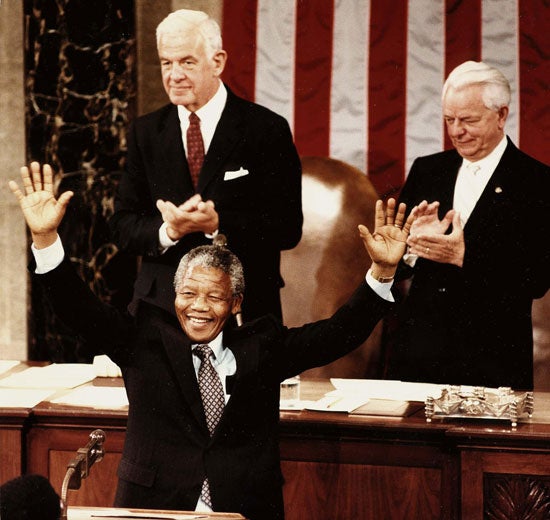FBI spied on Nelson Mandela during 1990 US visit, files show
Newly released records reveal death threats against the South African leader
Your support helps us to tell the story
From reproductive rights to climate change to Big Tech, The Independent is on the ground when the story is developing. Whether it's investigating the financials of Elon Musk's pro-Trump PAC or producing our latest documentary, 'The A Word', which shines a light on the American women fighting for reproductive rights, we know how important it is to parse out the facts from the messaging.
At such a critical moment in US history, we need reporters on the ground. Your donation allows us to keep sending journalists to speak to both sides of the story.
The Independent is trusted by Americans across the entire political spectrum. And unlike many other quality news outlets, we choose not to lock Americans out of our reporting and analysis with paywalls. We believe quality journalism should be available to everyone, paid for by those who can afford it.
Your support makes all the difference.The FBI spied on Nelson Mandela on his historic visit to the US months after his release from prison, newly released files have revealed.
When the South African leader arrived in June 1990, the agency already had tabs on his movements from an informant close to his entourage.
At the time, his party the African National Congress was still designated as a terrorist organisation by the US government but Mr Mandela received a rapturous welcome on his tour of eight cities.
He had just been released from prison after 27 years and had become an international icon for his struggle against apartheid.
Released memos show he was in contact with Coretta Scott King, Martin Luther King’s widow, and had been asked to meet Louis Farrakhan, the Nation of Islam leader that he did not see for another six years.
The partially redacted files, obtained Ryan Shapiro and shared with Al Jazeera, contain 334 pages of FBI records from June 1990.

Mr Shapiro, from the Massachusetts Institute of Technology, is involved in an ongoing legal battle with the National Security Agency, CIA and Defence Intelligence Agency for records on Mr Mandela.
He said: “Not only did the FBI heavily redact and withhold documents, but there’s virtually no discussion of U.S. intelligence community involvement prior to Mandela’s 1990 release from prison.”
One of the challenges for security services in the visit was keeping Mr Mandela safe in the wake of numerous death threats.
“Remember John F. Kennedy in Dallas?? Bring this black murderer to Houston and we will give him a welcome the world will not forget!!!” read a handwritten letter sent to the Houston Chronicle on 26 May.
There were also calls from people threatening to kill Mr Mandela to police and the Georgia Institute of Technology, where he was due to appear.
One man claimed he and accomplices had “weapons and means” for the assassination and had received military training, according to an FBI report.
The State Department was concerned about the South African leader being a target for domestic terrorist activity and the threat level was classified as “high”.
The FBI logged threats from white supremacists, a neo-Nazi group, the Ku Klux Klan, the Aryan Knights of the Great Forest and other groups.
Although the FBI and police investigated, no arrests were made.
During Mr Mandela’s six-week tour of the US and Europe, he spoke against apartheid and urged foreign governments to maintain economic sanctions against the South African regime in place until democratic elections were held.
He was elected as South Africa’s President four years later but concerns over his safety abroad continued in 2000, when the State Department again predicted a threat from right-wing extremists on his visit to the US.
Join our commenting forum
Join thought-provoking conversations, follow other Independent readers and see their replies
Comments